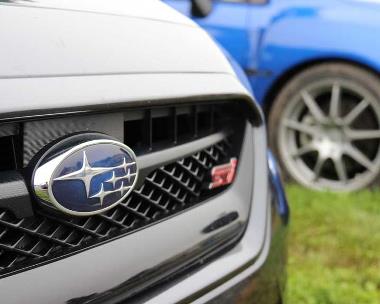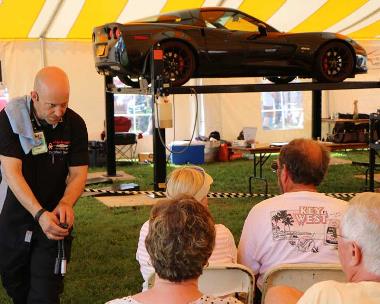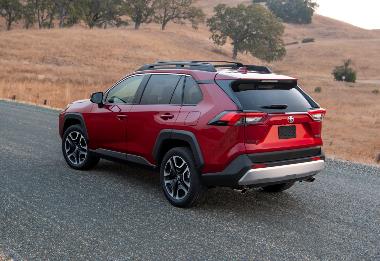The original Toyota RAV4 arrived in the United States 22 years ago, casting the mold for a new industry segment, which evolved into the compact crossover SUV. The hip, sporty, small crossover was named for being a “Recreational Active Vehicle with 4-wheel drive” (RAV4), although not all RAV4s have four wheel drive.
Popular from the beginning and garnering 408,000 vehicle sales in the U.S. last year, RAV4’s detractors have said it was too small, too slow and not inspiring. Taking that to heart, the 2019 RAV4 has been re-imagined for its 5th generation and is being marketed as a perception shift. Keying on that in Toyota’s Super Bowl commercial, the ad focuses on 22-year-old (get the 22-year symbolism) Antoinette “Toni” Harris, a sophomore defensive back at East Los Angeles College. Harris is the first female football player to play a non-specialist position, and was the first woman to be offered a full scholarship as a non-specialist on defense. The key lines are: “They said she was too small … too slow …too weak. They said she would never get to the next level … never inspire a new generation. People have made a lot of assumptions …” Harris says: “I have never been a fan of assumptions.” And neither is Toyota, who says, “Let’s go places,” as they bring RAV4 to the next level.
To that end, the 2019 Toyota RAV4 gets a major update with a new look, a new chassis and upgraded standard connectivity and safety technology. Larger and sitting higher with greater ground clearance, the all-new RAV4 loses a bit of the old sportiness in favor of a rounded and bold SUV look, with a prominent grille, flat nose, brawny shoulders and sculpted character lines. Inside, the interior design of the 2019 RAV4 has a more premium look and feel compared to the 2018 version. Like the exterior, the look of the interior can change quite a bit based on your trim of choice. For example, the Adventure grade has a more rugged interior with orange trim, while the Limited model has a more premium, upscale interior.
Available in naturally aspirated and hybrid models, the new design is based on Toyota’s new Global Architecture platform for a solid foundation and improved driving dynamics, comfort, and safety. The all-new RAV4 keeps its compact dimensions with a 105.9-inch wheelbase (a gain of 1.2 inches over last-Gen), and a length of 180.9 inches (down 0.2 inches). Height gains 1.3 inches at 67.2 for my test model, while width is 0.4 inches wider at 73.0 Ground clearance has gained a soft-road worthy 2.3 inches to 8.4 inches, and RAV4 has lost about 100 pounds to a range of 3380 to 3490 pounds depending on trim.
Musclewise, non-hybrid RAV4 grades are powered by an efficient 2.5-liter Dynamic Force 4-cylinder engine that delivers 203 hp and 184 lb-ft of torque, a gain of 27 horses and 12 lb-ft over last year. The AWD version is rated at 25mpg/city and 33mpg/hwy. The RAV4 Hybrid is also powered by a 2.5, assisted with an electric motor on the rear axle. The combined system output is 219 hp, and 400 lb-ft, and backed by an electronically controlled continuously variable transmission, is rated at 41/37 with a combined average of 39mpg. My naturally aspirated test ride achieved an average of 29.7mpg in mixed-use town, highway and softroad driving in wintry conditions. RAV4 has always been favored as a pavement ride, but it can handle soft-road diligently and light off-road well.
In track tests on non-groomed pavement, not the best for timing trials, my RAV4 managed an 8-second-flat zero-to-60 run and a 16.2-second quarter-mile. The compact was attentive, steered well for the niche, exhibited only slight sway and top-wobble during quick-turning, and while noisy (engine noise) inside, offered a supple ride.
The RAV4 cabin is sporty and accommodating and filled with infotainment including a 6-speaker Entune™ Audio system with 6.1-inch touchscreen. Front headroom is a bit tight, but expected for the niche, at 39.5 inches (0.3 inches less than last year), with 39.5 also in row two (a gain of 0.6). Legroom is accommodating at 41.0 inches in row one (though a loss of 1.6 inches) with 37.8 inches (up 0.6) for second-seat passengers and there is a wide-body 57.8 inches of shoulder room in front (up 0.5) with an inch more room in this year’s row two, at 56.4 inches.
From a safety perspective, RAV4 is on point with the Toyota Safety Sense™ 2.0 Pre-Collision System with Pedestrian Detection, which includes pedestrian detection, Lane Departure Alert, Dynamic Radar Cruise Control, Road Sign Assist, Lane Tracing Assist and Steering Assist. RAV4 also has Star Safety System™ with Traction Control, Electronic Brake-force Distribution, Enhanced Vehicle Stability Control, Brake Assist, Anti-lock Braking System and Smart Stop Technology. Eight standard airbags consist of dual stage advanced driver and front passenger airbags; front seat-mounted side airbags; first and second row side curtain airbags; driver’s knee airbag and a front passenger seat cushion airbag.
The base RAV4 Hybrid starts at $27,385 plus a delivery fee of $930, and the RAV4 LE bases at $25,500, with the XLE at $27,300, the XLE Premium at $29,500, the sporty Adventure at $32,900 and the Limited at $33,500, loaded with standard tech, safety and cosmetics. My test RAV4 Limited added Dynamic Torque Vectoring AWD for $1400; Ruby Flare Pearl (Deep Red) paint for $395 (mated to a Black Softex interior at no extra charge); Entune™ 3.0 premium audio with Dynamic Navigation added $580; all-weather floor and cargo liners added $169; mudguards added $129; a running board added $549; roof rack cross bars added $315; and delivery, processing and handling added $1095 for a sticker-as-tested of $38,232.
Visit www.CarlisleEvents.com for more on the automotive hobby.
Mike Blake, former editor of KIT CAR magazine, joined Carlisle Events as senior automotive journalist in 2004. He's been a "car guy" since the 1960s and has been writing professionally for about 30 years.














